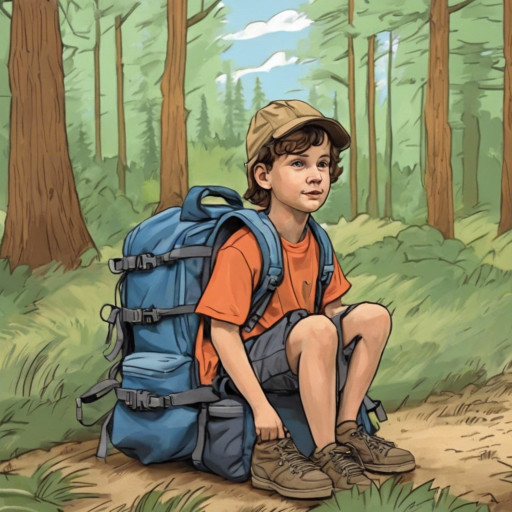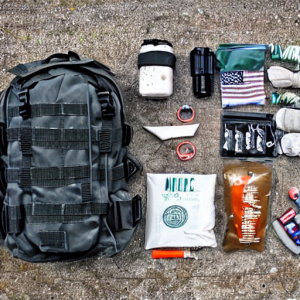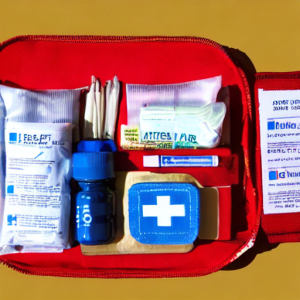A Comprehensive Guide to Packing Bug Out Bags for Children
In our capacity as parents, the fundamental obligation that we have is to look out for the health and safety of our children. Even though we wish for the best, it is of the utmost importance to be ready for any unexpected catastrophes or disasters that may arise. One of the most important components of any disaster preparedness plan is a bug out bag, which is a collection of critical items that will allow you and your family to survive until an emergency response team arrives. Today, we are going to concentrate on a topic that is frequently disregarded: the preparation of bug out bags that are catered to children. The purpose of this all-encompassing guide is to provide you with all the information you require to pack bug out bags that are specifically designed for your children.

Why Are Bug Out Bags for Children Important?
When it comes to emergency preparedness, the fragility of children is something that must be taken into special mind during times of crisis. The idea of bug out bags for children originates from a fundamental requirement to guarantee the safety and well-being of the younger members of our communities if unexpected events take place. By carefully putting together these survival kits that are specifically designed to meet the requirements of children, we not only provide them the ability to take an active part in ensuring their safety, but we also alleviate some of the pressure that is placed on carers in the event of an emergency.
As a result of their dependence on their parents or guardians for direction and safety, children frequently look to adults for comfort when they are experiencing a difficult situation. Adults may find themselves engaged with a variety of important duties during times of emergency, including the preparation of evacuation plans, the making of decisions, and the conveyance of information. When it comes to ensuring that a child can withstand difficult circumstances on their own, at least for a certain amount of time, a bug out bag that has been meticulously packed for them becomes an indispensable instrument.
There is more to the concept of bug out bags for children than just the practicality of survival goods; they also have an empowering significance. The development of a sense of responsibility and resiliency in young people is facilitated by it. It is not only that children are better prepared for unexpected events when they have their bags, but they also get a certain degree of control over the world that is immediately surrounding them. This sense of agency can contribute to the emotional well-being of a kid during times of crisis, fostering a feeling of security and self-efficacy in the child when going through difficult times.
From a physical standpoint, children have specific requirements that are distinct from those of adults. They have varied dietary needs since their bodies are still developing, and their bodies are still developing. Therefore, bug out bags for children should have an assortment of food, clothing, and medical supplies that are suitable for their age group. Goods such as diapers, formula, or particular drugs that are tailored to meet the specialized requirements of younger individuals must receive special attention. During challenging times, this customization helps to guarantee that the child’s bodily needs are met, which contributes to the child’s general health and comfort.
Children react to stress in different ways than adults do, both emotionally and psychologically. It is important to recognise the psychological well-being of children during times of emergency, and the inclusion of comfort products in bug out bags is doing just that. Toys that are familiar to the child, a blanket that is cherished, or other items that hold personal importance can provide a source of comfort and stability, assisting in the reduction of anxiety and terror. Taking into account the psychological requirements of children when making bug out bags for them is an example of how the holistic approach to emergency preparedness may be strengthened.
The fact that a child’s bug out bag contains materials that are suitable for their age serves as a reminder that emergency readiness is not a concept that can be applied universally. In the same way that we take into account the specific requirements of people who have impairments or medical illnesses, we also need to acknowledge that children require a different strategy when it comes to being prepared. By providing bug out bags that are specifically designed to meet the requirements of the younger members of our communities, we ensure that they are not neglected in the process of emergency planning.
Choosing the Right Bug Out Bag
 When selecting a suitable bag for a child’s requirements for a bug out, it is important to give careful consideration to both the bag’s practicality and its level of comfort. To ensure that the child can carry their emergency supplies in a manner that is both comfortable and efficient, the selection of the appropriate rucksack is of the utmost importance. This will contribute to the child’s general well-being amid difficult circumstances.
When selecting a suitable bag for a child’s requirements for a bug out, it is important to give careful consideration to both the bag’s practicality and its level of comfort. To ensure that the child can carry their emergency supplies in a manner that is both comfortable and efficient, the selection of the appropriate rucksack is of the utmost importance. This will contribute to the child’s general well-being amid difficult circumstances.
One of the most important features to look for in a rucksack is the presence of various compartments, as this is an important aspect of functionality. A practical answer to the problem of organization is provided by these compartments, which make it possible to arrange a variety of supplies methodically. Being able to quickly and easily access vital materials is made possible by having a well-organized bag, which is why having such a bag is so important in the event of an emergency. Not only does the capability of segregating commodities like water, snacks, clothing, and first aid supplies make the process of retrieval more efficient, but it also guarantees that resources are utilized effectively during the important opening moments of an emergency.
The evaluation of the backpack’s fit and whether or not it is compatible with the child’s physique is the other factor that is equally significant. An improperly fitting bag might cause the youngster to experience discomfort, strain, and even the possibility of developing health problems. For this reason, parents and other carers need to pay attention to the dimensions of the rucksack, how it distributes weight, and its overall design. To tailor the fit to the child’s height and form, it is important to look for features such as adjustable straps. In addition to making the bag more comfortable, this modification makes it less likely that the child will sustain injuries or experience physical strain, which makes it easier for the youngster to carry the bag.
The importance of a rucksack that fits properly extends beyond the child’s physical comfort; it also has an impact on the child’s level of self-assurance and ability to move quickly and confidently during an emergency evacuation. A bag that is properly fitted guarantees that the child can retain balance and stability when they are moving around. This contributes to a sense of security and control in what may otherwise be a chaotic scenario. In the context of the overall preparedness plan for children, the consideration of functionality in conjunction with the ergonomic design is an essential component.
Parents need to include their children in the decision-making process, taking into account their preferences and the degree to which they are comfortable. Children are more likely to accept the responsibility of owning their bug out bag if the experience is made collaborative. Furthermore, empowering children and reinforcing their sense of ownership over their emergency supplies can be accomplished by incorporating them into the decision-making process.
Ensuring Proper Hydration
It is impossible to stress the relevance of maintaining an adequate level of hydration when it comes to the preparation of children for emergencies. In the event of an emergency, maintaining proper hydration is even more important than it already is, as it is a crucial component of preserving health and well-being. When putting together your child’s bug out bag, making sure that water-related goods are at the top of your list of priorities becomes an essential part of their readiness approach.
Taking preventative measures to ensure that your child has access to a dependable and portable source of hydration, such as including a lightweight water bottle or a hydration pack that is specifically made for children, is an example of a proactive approach. The selection of an appropriate container is not only about convenience but also about taking into consideration the specific requirements and capabilities of children. Make sure to choose a design that is simple for them to handle and transport, as this will encourage kids to take responsibility for managing their water supply in the event of an emergency.
In addition, the incorporation of a hydration pack has a dual purpose: it not only makes it easier for children to carry water without having to use their hands, but it also makes the activity more interesting and enjoyable for them. As a result of the fact that these packs are frequently created with vivid colors and features that are child-friendly, they change a fundamental requirement into an accessory that is more enticing and encourages regular water consumption.
Take advantage of the opportunity to educate your youngster on the significance of maintaining proper hydration while you are in the process of packing the water supplies. It is important to educate kids on the importance that water plays in sustaining their health, especially when they are facing difficult situations. Stress the need for water not only for satiating thirst but also for maintaining overall bodily processes, particularly during times of stress or physical activity. Water is extremely important for both of these reasons.
You should not only stress the significance of drinking water consistently, but you should also talk to your child about the symptoms that indicate that they are becoming dehydrated. When you teach kids to recognise symptoms like dizziness, weariness, or dark urine, you give them the ability to take charge of monitoring their hydration levels and take preventative measures. The acquisition of this knowledge provides children with a crucial skill set that enables them to take responsibility for their well-being and successfully convey their requirements, even in the aftermath of an emergency.
When it comes to preparing children for unexpected events, one of the most important things to do is to encourage both a proactive and knowledgeable approach to hydration. Through the incorporation of these teachings into the process of putting together their bug out bag, you are not only meeting their immediate requirements, but you are also equipping them with vital life skills that will empower them over time. When it comes to creating a sense of self-sufficiency, resilience, and responsibility in children as they navigate through unforeseen events, the focus placed on hydration becomes a vital factor.
Nutrition and Food Supplies
The amount of food that a youngster consume has a significant impact on their overall health, particularly when they are confronted with stressful circumstances. During the process of methodically putting together your child’s bug out bag, the addition of non-perishable food items becomes an essential component. This ensures that your child’s nutritional requirements are covered even in the face of unforeseen problems.
 When it comes to picking food items for the bug out bag, choosing selections that are both diverse and nutritious should be at the forefront of your priorities. Granola bars, fruit snacks, and meal replacement bars are all options that are considered to be practical because they do not require refrigeration and are simple to consume. Not only do these goods supply the basic nutrients that a child needs, but they also provide a solution that is both convenient and portable for maintaining a child’s energy levels in times of need.
When it comes to picking food items for the bug out bag, choosing selections that are both diverse and nutritious should be at the forefront of your priorities. Granola bars, fruit snacks, and meal replacement bars are all options that are considered to be practical because they do not require refrigeration and are simple to consume. Not only do these goods supply the basic nutrients that a child needs, but they also provide a solution that is both convenient and portable for maintaining a child’s energy levels in times of need.
When it comes to catering to the refined taste buds of children, it is important to remember that emphasizing nutritional content does not entail losing flavor. Choose solutions that are not only healthful but also pleasing to the taste buds of young people (young people). During difficult circumstances, this thoughtful selection encourages children to voluntarily accept the food that is supplied, which is beneficial to both their physical health and their mental comfort.
The incorporation of a wide range of food items that can satisfy a variety of dietary requirements is an example of a strategic approach. Granola bars may provide a rapid dose of carbohydrates and energy, but fruit snacks are considered to be more beneficial because they contain critical vitamins and minerals. On the other hand, meal replacement bars have the potential to offer a more comprehensive nutritional profile, which guarantees that the child will consume a balanced diet through their use. As a result of this diversity, the varied requirements of a growing and developing body are addressed, which further emphasizes the significance of maintaining a balanced diet even in an emergency.
It is essential to perform regular checks on the expiration dates of the bug out bag to ensure that it continues to be effective over time. The term “non-perishable” does not necessarily mean “indefinite freshness,” and replacing food items that are getting close to their expiration date is a preventative strategy to ensure that your child has access to a variety of options that are both safe and nutritious. Additionally, this routine enables adjustments to be made to the child’s ever-changing preferences and dietary requirements.
Not only do these food items provide children who are going through difficult circumstances with the ability to satisfy their physical needs, but they also play a significant part in reducing stress and giving them a feeling of normalcy. Snacks that are familiar to children can serve as a source of comfort, assisting them in coping with the unpredictability of emergencies. When you take the time to carefully pick and routinely replenish the non-perishable food products that are contained within your child’s bug out bag, you are not only meeting their immediate nutritional needs, but you are also fostering their mental well-being during times of crisis. Within the context of emergency preparedness, this holistic approach to eating highlights the significance of taking into consideration both the physical and emotional aspects of a child’s well-being.
Clothing and Protective Gear
In the process of putting up a comprehensive bug out bag for your child, paying close attention to the clothing they bring becomes an essential component of their sense of readiness. Not only is it a matter of comfort to include additional garments that are adapted to the current climate and weather conditions in your region, but it is also an essential component in ensuring that they remain healthy and safe in the event of an emergency.
Consider the fundamentals, like bringing additional socks and pants, which are frequently missed necessities but can make a major difference in the level of comfort experienced by a child. In addition to being essential for the upkeep of hygiene, these goods also contribute to a sense of normalcy and well-being, which is especially important when one is confronted with difficult situations. A warm hat is another flexible accessory that may be worn in a variety of situations. It offers protection against the elements and insulation, particularly when the temperature drops.
 The provisions for clothes go beyond the fundamentals, and the selection should be influenced by the age of your child, the size of your child, and the particular weather patterns that are usual in your region. If you have younger children, you should think about carrying rain gear to protect them from sudden downpours. In colder climates, gloves can be extremely useful since they protect young hands from the harmful effects of cold temperatures. To guarantee the child’s mobility and safety during evacuation scenarios, it is vital to provide them with sturdy shoes that are suited for walking or potentially traversing a variety of terrain.
The provisions for clothes go beyond the fundamentals, and the selection should be influenced by the age of your child, the size of your child, and the particular weather patterns that are usual in your region. If you have younger children, you should think about carrying rain gear to protect them from sudden downpours. In colder climates, gloves can be extremely useful since they protect young hands from the harmful effects of cold temperatures. To guarantee the child’s mobility and safety during evacuation scenarios, it is vital to provide them with sturdy shoes that are suited for walking or potentially traversing a variety of terrain.
As children become older, their demand for clothing also increases. To accommodate their ever-changing size and evolving requirements, the clothes contained in the bug out bag must undergo regular evaluations and updates. Not only does a well-fitted item of clothing offer comfort, but it also makes movement easier, which is an essential quality to have in the event of an emergency, where agility and mobility may be necessary.
The shifting of the seasons adds a layer of complexity to the factors that should be considered when selecting apparel. Something appropriate during one season could not be sufficient during another season. Because of this, it is necessary to alter the contents of the bug out bag according to the season. With this adaptability, you can be assured that your child will be sufficiently equipped for a wide range of weather conditions, whether it be the sweltering heat of summer or the cold and rainy circumstances of winter.
Comfort Items and Entertainment
Recognizing the emotional impact that emergency events have on children highlights the significance of including objects that provide comfort in their bug out bag. When it comes to supporting their mental well-being during times of uncertainty, the presence of goods that create a sense of security and familiarity becomes an essential component. This is in addition to the essential supplies and provisions that are physically present.
Take into consideration the great comfort that your child receives from their favorite stuffed animal when you are making the bug out bag for your child. When confronted with the unknown, this lovable friend acts as more than just a toy; it becomes a source of comfort and reassurance for the individual receiving it. In a similar vein, a tiny blanket can provide both physical warmth and emotional comfort, serving as a familiar touchstone during the confusion that is caused by emergencies.
A youngster may find it reassuring to have a treasured book in their bug out bag. Familiarity is a powerful antidote to fear, therefore include a book that the child has always loved in the bag. When a known narrative is readily available, it can act as a grounding mechanism, providing a sense of continuity and stability in the face of disturbance. This is true whether the narrative is a good nighttime story or a picture book that is cherished by the child.
Furthermore, the incorporation of games, puzzles, or other minor activities is a clever strategy to keep children involved and diverted from the potentially painful events that are taking place around them. These diversions have a dual purpose, not only providing a sort of amusement but also providing a productive release for pent-up energy or tension. They are designed to suit both of these purposes. When faced with difficult situations, engaging in activities such as coloring books, compact puzzles, or simple card games can provide a welcome reprieve and contribute to a more positive outlook for the individual.
There is no possible way to overstate the psychological influence that comfort products have. Children might benefit greatly from having physical reminders of normalcy while they are under stress. These things are more than just distractions; they become anchors, providing children with a sense of familiarity and security in times when the world around them may appear to be turbulent and unpredictable.
As a carer, the intentional curation of comfort items in the bug out bag displays a dedication to addressing not only the physical needs of a kid but also their emotional well-being. This is necessary to safeguard the child’s mental health. It indicates a grasp of the specific problems that children encounter during times of emergency and the significance of providing them with the resources necessary to negotiate these obstacles with a sense of security and resilience. These comfort goods, in the end, contribute to the holistic strategy of preparing children for emergencies, which recognizes and addresses both the children’s practical demands as well as their emotional needs.
Essential Supplies
 Not only should the goods that were listed above be included in every bug out bag for children, but there should also be other important supplies included. In the event of an emergency, each of these items will contribute to ensuring their safety and well-being. Included on this list of necessary goods is a checklist:
Not only should the goods that were listed above be included in every bug out bag for children, but there should also be other important supplies included. In the event of an emergency, each of these items will contribute to ensuring their safety and well-being. Included on this list of necessary goods is a checklist:
1. First Aid Kit: It is essential for any bug out bag to contain a first aid kit that is adequately equipped. Include any required drugs or specialized medical supplies that your child requires, as well as band-aids, antiseptic wipes, gauze pads, and an emergency blanket.
2. Personal Identification and Contact Information: Make sure to include a laminated card with your child’s name, address, emergency contacts, and any other important medical information if you become separated from them.
3. Flashlight and Batteries: In low-light situations, having a portable torch that is both comfortable and helpful can be of great use. LED flashlights are a better option because they are not only lightweight but also have a longer battery life.
4. Personal Hygiene Items: Bring along travel-sized versions of your personal care items, like hand sanitizer, toothpaste, toothbrush, and soap. The incorporation of these things will assist in the maintenance of hygiene and the prevention of the transmission of germs.
5. Whistle: Instruct your youngster on the significance of drawing attention to themselves when it is required. By including a whistle in their bug out bag, they will be able to signal for assistance in the event of an emergency emergency.
6. Cash and Important Documents: Be sure to include copies of crucial documents, such as birth certificates, passports, and insurance information, as well as a modest quantity of cash in small denominations.
7. Emergency Contact List: A laminated list of emergency contacts should be included, along with other pertinent information such as phone numbers, addresses, and instructions to secure meeting sites.
Educating Your Child
The act of putting together bug out bags is not a stand-alone activity; rather, it is supported by an equally important component, which is providing knowledge. The children are provided with tangible resources when they put together the bag; nevertheless, the knowledge that is conveyed to them about the purpose of the bag and how it should be used is an essential step in the process of developing their capacity to respond successfully to potential emergencies.
You are investing in your child’s preparedness and confidence by taking the time to teach them about the items that are contained in their bug out bag with you. Explain the use of each item, removing any mystery about the inclusion of particular items. This not only helps students get more familiar with the tools that are available to them, but it also fosters a sense of responsibility and ownership over their emergency kit. The bug out bag becomes a resource that children can actively utilize rather than a mystery collection of stuff when they are aware of how to use each item, which empowers them.
To further reinforce the practical knowledge that was acquired during the educational phase, it is common practice to conduct periodical drills or simulations. Within the context of an emergency, these exercises provide children with opportunities to put what they have learned into practice, assisting in the consolidation of their comprehension of the significance of maintaining composure and according to instructions. Simulations can range from straightforward situations, such as practicing how to correctly put on a rain poncho, to more complicated scenarios, such as evacuating a specific location. The objective is to establish a sense of preparedness and familiarity in children so that, in the event of a genuine emergency, they will be able to draw upon the knowledge they have gained through practice to handle the situation effectively and remain calm.
In addition to the practical requirements of using the bug out bag, education is an essential component in the process of molding a child’s mentality in the event of an emergency. Instruct them on the significance of maintaining composure, highlighting the fact that having a clear head permits improvement in decision-making and responsiveness. You should talk about how important it is to obey directions, regardless of whether they come from you, other carers, or emergency assistance people. Because of this foundation of knowledge, the bug out bag is transformed from a simple collection of materials into a full tool kit that provides children with both the physical resources and the mental strength to tackle unforeseen obstacles.
Creating a Routine
The effectiveness of a bug out bag for children is not limited to the initial packing of the bag; rather, it requires a commitment to doing regular checks and updates to maintain its effectiveness. The establishment of a routine for reviewing and replenishing the contents of the bag is an essential stage in the process of ensuring that it continues to be a dependable resource in times of need. This practice not only addresses practical difficulties, but it also instills a sense of responsibility in your child, which helps them develop a better awareness of the significance of being prepared.
The bug out bag should be checked regularly as a preventative precaution to ensure that it contains goods that are both functional and up to date. It is of the utmost importance to inspect for things that have expired or been damaged, as these can potentially undermine the efficiency of the supply. By way of illustration, drugs that have expired or pills that purify water might not function as they were designed to, which would make them less reliable in the event of an emergency. The readiness and dependability of the bag can be maintained by recognizing and replacing items of this nature during routine checks.
Your child’s participation in this routine serves several functions on multiple fronts. To begin, it emphasizes the importance of shared responsibility by highlighting the fact that being prepared is a group effort being made by everyone. Through their participation in the inspection process, children can acquire a practical grasp of the contents of the bug out bag as well as the significance of those contents. Because of this engagement, the bag is transformed from a passive emergency resource into an active instrument that they are responsible for sustaining because of their participation.
The second benefit is that involving your child in the routine checks helps them develop a sense of ownership over their level of preparation. Children internalize the concept that being prepared is a personal responsibility as they actively participate in ensuring the contents of the bag are up to date. This sense of ownership can transfer into a more confident and robust mindset during times of emergency since children are aware that they have actively contributed to their readiness.
In addition, the routine reviews offer the chance to have continuing conversations about whether or not emergency preparations are satisfactory. To ensure that they have a better grasp of how the items in the bag contribute to their safety and well-being, you should take advantage of these moments to review the functions of each item contained within the bag. To address any issues or ambiguities that they might have, it is important to encourage open conversation and questioning.
The post How to Pack Bug Out Bags for Kids appeared first on Survivalbite.
The post How to Pack Bug Out Bags for Kids appeared first on https://gqcentral.co.uk




Comments are closed